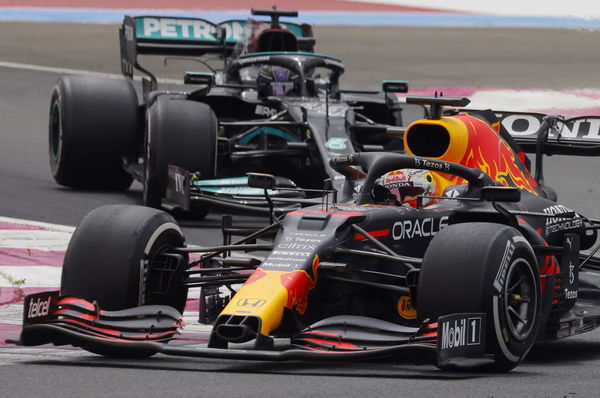
via Reuters
Formula One F1 – French Grand Prix – Circuit Paul Ricard, Le Castellet, France – June 20, 2021 Red Bull’s Max Verstappen and Mercedes’ Lewis Hamilton in action during the race REUTERS/Eric Gaillard

via Reuters
Formula One F1 – French Grand Prix – Circuit Paul Ricard, Le Castellet, France – June 20, 2021 Red Bull’s Max Verstappen and Mercedes’ Lewis Hamilton in action during the race REUTERS/Eric Gaillard
It is a known fact that Mercedes have been the strongest F1 team of the ongoing hybrid era, having secured 14 championship titles.
However, 2021 ended up writing a different script altogether; Red Bull Racing, finally woke up from their 7-year hibernation.
The Milton-Keynes outfit are looking quite dangerous at the moment and strong enough to stop Mercedes’ dominant run in F1. And of course, part of the credit goes to Honda, who managed to design a prodigious engine over their farewell season.
ADVERTISEMENT
Article continues below this ad
However, there seems to be another factor that could be playing a huge role in Red Bull’s successful 2021 outing; the rear wing.
How the rear-wing controversy unfolded
Red Bull caught their rivals’ attention at the Spanish Grand Prix, earlier this season by allegedly sporting flexible rear wings. It was Lewis Hamilton, who initially started off the proceedings by giving his team a heads-up following the race.
“The Red Bulls are very fast on the straights. They have a bendy wing on the back of their car, which they put on today. As a result, they have gained at least three tenths in speed,” Hamilton said.
The Briton spent a handful of laps following Max Verstappen and might have noticed something strange happening to the Red Bull’s rear wing.

via Reuters
Formula One F1 – French Grand Prix – Circuit Paul Ricard, Le Castellet, France – June 19, 2021 Red Bull’s Max Verstappen and Mercedes’ Lewis Hamilton Pool via REUTERS/Nicolas Tucat
The Brackley outfit consequently reported the issue to the FIA in a bid to halt Red Bull’s brief dominance. And the importance Mercedes were investing in the flexi-wing row clearly suggested that the Christian Horner-led team was enjoying a lot of advantages.
Is aeroelasticity helping Red Bull against Mercedes?
‘No’ is the answer. Following Mercedes‘ report to the FIA at Baku, Red Bull complied with the rules and fitted an updated rear wing to both the cars in France. And what was the outcome? Well, the Milton Keynes outfit are still the fastest on the track.
They’ve consequently disproved the claims that the flexi-wings had been providing them with a substantial pace advantage over Mercedes.
“We’ve had accusations made. But we’ve complied with the rules and the way that we’ve reacted I think shows the strength and depth, that our performance isn’t based on rear wing flexibility,” Horner said.
Although the cars possess a tinge of elasticity to their rear wings, they don’t seem to be breaching F1 and FIA’s regulations.
How flexi-wing improvises the pace of an F1 car
Let’s consider Mercedes for instance. One of Mercedes’ strengths has always been their straight-line speed. And the flexi-wing most likely shatters that advantage. Why you might ask?
Introducing aeroelasticity into the wings can help produce more drag and consequently improve the velocity of the car.
ADVERTISEMENT
Article continues below this ad

via Reuters
Formula One F1 – French Grand Prix – Circuit Paul Ricard, Le Castellet, France – June 19, 2021 Red Bull’s Max Verstappen in action during practice REUTERS/Yves Herman
Hence, Mercedes drivers, on several occasions, have struggled to keep up with Red Bull on the straights despite using the slipstream to full effect.
Overall, with Red Bull clearing the allegations over the flexing wing controversy, are Mercedes out of options to halt their rivals’ dominance this season?
ADVERTISEMENT
Article continues below this ad
ADVERTISEMENT
ADVERTISEMENT
ADVERTISEMENT
ADVERTISEMENT

